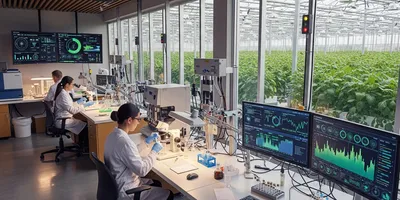Introduction
Agriculture and food science are undergoing a seismic transformation. Feeding nearly 10 billion people by 2050 while protecting natural ecosystems, mitigating climate change, and ensuring global food equity requires a re-imagining of how science supports agriculture. Laboratories—once viewed primarily as testing and quality-control centers—are now evolving into strategic engines for innovation and sustainability.
For laboratory managers, this shift presents both a challenge and an opportunity. The “agri-lab” of the future will not only measure nutrients, contaminants, and yield; it will serve as a dynamic node connecting farmers, researchers, policymakers, and consumers through data, innovation, and sustainability. It will help drive circular food systems, validate climate-smart practices, and develop the scientific insights needed for resilient agriculture.
The Changing Role of the Agricultural Laboratory
Historically, agricultural laboratories have focused on soil, water, and crop analysis—ensuring product safety and compliance. Today, the demands are far greater. Global supply chains, consumer transparency, and environmental performance are all under scrutiny. New sustainability frameworks, from carbon accounting to regenerative agriculture, depend on robust data.
In this new paradigm, laboratories are expected to go beyond compliance. They must help companies quantify greenhouse-gas emissions, assess nutrient cycling, and validate claims such as “regeneratively grown” or “zero-waste.” Analytical data becomes the foundation of accountability.
A forward-looking laboratory now participates in product innovation, circular-economy initiatives, and digital transformation. Testing food products for nutritional content is only one part of its remit. Modern labs analyze by-products for potential reuse, model water efficiency, track biodiversity indicators, and integrate data from remote sensors in the field.
This convergence of sustainability science, data analytics, and precision agriculture is redefining what it means to manage a laboratory.
Technology Driving Change
One of the most significant developments reshaping agricultural research is the integration of digital and automation technologies. Smart farming systems equipped with Internet-of-Things (IoT) sensors generate vast amounts of data about soil moisture, nutrient levels, and weather conditions. Laboratories increasingly act as the analytical backbone that verifies, calibrates, and enriches this data.
Automation in the lab mirrors automation in the field. Robotic liquid handlers, high-throughput analyzers, and artificial-intelligence-driven data pipelines are streamlining sample processing and improving reproducibility. The same technologies used in pharmaceutical and materials science labs are now being deployed for food and agricultural applications—speeding up testing, reducing human error, and enabling continuous monitoring.
Digital connectivity also allows labs to work as part of an ecosystem. Laboratory Information Management Systems (LIMS) can now link directly with farm management platforms, ensuring that agronomic decisions are based on verified scientific data. This integration allows for predictive modeling—using lab data to anticipate disease outbreaks, optimize fertilization, or predict post-harvest shelf life.
Sustainability as a Core Mission
Laboratories themselves are resource-intensive environments. Energy-hungry equipment, high volumes of consumables, and frequent reagent use all contribute to a facility’s environmental footprint. The agri-lab of the future incorporates sustainability not just in what it tests, but in how it operates.
Managers are increasingly adopting green-lab practices: optimizing freezer management, consolidating instrument use, switching to energy-efficient models, and minimizing solvent waste. Some organizations now include lab sustainability metrics—such as carbon intensity per test—in their corporate ESG reporting.
Lab Quality Management Certificate
The Lab Quality Management certificate is more than training—it’s a professional advantage.
Gain critical skills and IACET-approved CEUs that make a measurable difference.
Design also plays a role. Modular layouts, flexible workstations, and shared instrumentation reduce duplication and allow rapid reconfiguration as projects evolve. Forward-thinking facilities are being built or retrofitted to support both traditional QC and experimental R&D, ensuring that as research directions shift—from soil health to plant genomics to waste valorization—the lab can adapt.
Building a Culture of Collaboration
Perhaps the most profound change for lab managers lies in collaboration. Sustainable food systems demand a networked approach that bridges agronomists, food technologists, data scientists, and policymakers. The lab is no longer a siloed endpoint of the production chain; it’s a collaborative hub that connects field and factory, science and society.
To operate effectively within this ecosystem, lab managers must champion transparency and shared objectives. That means integrating their operations into cross-functional sustainability teams, aligning test programs with supply-chain goals, and participating in pilot projects that explore new pathways—such as transforming crop residues into high-value bioproducts or monitoring greenhouse gases in regenerative farms.
Training and professional development also evolve. Staff must become fluent in data literacy, systems thinking, and sustainability reporting, complementing their analytical expertise.
Case Study: Wageningen University & Research, The Netherlands

Panorama of the campus of Wageningen University & Research
Van Gooien, CC BY-SA 4.0 via Wikimedia Commons
Few institutions embody the agri-lab of the future as vividly as Wageningen University & Research (WUR) in the Netherlands. Often cited as the world’s leading agricultural research ecosystem, WUR operates a network of advanced laboratories supporting everything from soil health to food innovation to circular-economy research.
The Wageningen Food & Biobased Research (WFBR) labs serve as a model of how analytical science supports sustainable food systems. Their researchers collaborate directly with industry partners to upcycle agricultural by-products—such as potato peels and sugar-beet pulp—into high-value fibers, proteins, and bio-plastics. This not only reduces waste but also creates new revenue streams for farmers and processors.
In one project, WFBR scientists developed methods for extracting natural fibers from tomato plant stems—a waste stream previously destined for composting. By characterizing the fibers’ properties using advanced spectroscopy and chromatography, they demonstrated potential applications in sustainable packaging and textiles. The lab’s analytical rigor ensured product safety, performance validation, and scalability for industrial partners.
Beyond R&D, the laboratories at Wageningen have also embraced sustainability within their own operations. Energy-efficient ventilation systems, solvent-recovery programs, and digital sample-tracking have reduced both environmental impact and operational costs. The labs are part of the Wageningen Campus Living Lab, where every research building functions as a testbed for circular-economy design principles.
This real-world example shows that the agri-lab of the future is already taking shape—integrating science, technology, and sustainability into a cohesive, system-level enterprise.
Data Integration and the Digital Food System
As agriculture becomes more data-intensive, the interface between laboratory data and digital agriculture will define competitive advantage. Remote sensors, drones, and satellite imaging can monitor crop growth and soil conditions in real time, but they rely on laboratory calibration to ensure accuracy.
Modern agri-labs now participate in building “digital twins” of agricultural systems—virtual models that simulate how crops respond to changing environmental conditions. By feeding analytical data into these models, labs help farmers make data-driven decisions that conserve resources and enhance yields.
In turn, this digital integration requires strong data governance and interoperability. Lab managers must consider cybersecurity, metadata standards, and long-term data stewardship, ensuring that scientific results remain accessible and trustworthy.
Overcoming Barriers to Change
Transforming an agricultural laboratory into a sustainability-focused innovation hub does not happen overnight. Many managers face familiar obstacles: limited budgets, outdated equipment, fragmented data systems, and cultural resistance to change.
Investment justification is a key challenge. Sustainable upgrades—such as new instrumentation, automation systems, or energy-efficient infrastructure—require upfront capital. However, long-term returns often include lower utility costs, higher productivity, reduced waste disposal fees, and stronger reputational value. Lab managers should frame sustainability not as a cost, but as a business advantage.
Data integration presents another hurdle. Many labs operate legacy LIMS or manual systems that cannot easily connect to external databases. Modernizing these platforms can be complex, but the payoff is significant: integrated data enables traceability, predictive modeling, and better decision-making across the food chain.
Perhaps the most important ingredient for success is leadership. Laboratory managers who act as change agents—communicating a clear vision, engaging staff in continuous improvement, and demonstrating early wins—can transform their labs into models for the wider organization.
The Path Forward
As agriculture grapples with climate change, resource scarcity, and shifting consumer expectations, laboratories will play an increasingly central role in shaping solutions. The agri-lab of the future is one that connects science with action—bridging data, sustainability, and innovation.
For lab managers, this future begins with a few practical steps:
- Assess and align: Map your laboratory’s current capabilities and environmental footprint. Align testing programs with your organization’s sustainability goals.
- Invest in efficiency: Upgrade to energy-efficient instruments, automate repetitive tasks, and reduce chemical waste.
- Integrate data: Ensure laboratory systems connect seamlessly with production and agricultural data streams.
- Collaborate widely: Build partnerships with researchers, growers, and sustainability teams.
- Measure impact: Establish key performance indicators—such as energy per test, waste diverted, or value-added products created—and report them transparently.
These are not abstract ideals. They are tangible actions that turn laboratories into engines of progress for sustainable food systems.
Conclusion
The transformation of agriculture into a sustainable, resilient, and data-driven enterprise depends on the scientific infrastructure that supports it. Laboratories, long the guardians of quality and safety, are now becoming architects of change.
The agri-lab of the future is efficient, collaborative, and deeply integrated into the fabric of sustainable food production. It values data as much as samples, innovation as much as compliance, and stewardship as much as productivity.
As a laboratory manager, you are not just overseeing instruments—you are guiding the science that will feed the planet. The journey begins in your lab, one test, one dataset, and one innovation at a time.
Frequently Asked Questions
1. What is an “agri-lab,” and how is it different from a traditional agricultural laboratory?
An agri-lab is a modern agricultural laboratory designed to integrate sustainability, data analytics, and circular-economy principles into its operations. Unlike traditional labs focused solely on testing soil, water, or food products for compliance, an agri-lab serves as a hub for innovation—supporting sustainable food systems through digital connectivity, automation, and collaboration across the entire value chain.
2. How can laboratory managers make their facilities more sustainable?
Laboratory managers can begin by conducting an environmental audit of their operations to identify energy, water, and waste inefficiencies. Implementing energy-efficient freezers, optimizing HVAC systems, sharing instrumentation, and reducing single-use plastics all contribute to sustainability. Many labs are also adopting green-lab certification programs and integrating sustainability metrics—such as carbon intensity per test—into their key performance indicators.
3. What role does data integration play in the agri-lab of the future?
Data integration allows agricultural laboratories to connect field data (from sensors, drones, or satellites) with analytical results and production metrics. By linking these datasets, labs can provide predictive insights—for example, anticipating nutrient deficiencies, improving crop yield, or minimizing food waste. Effective data integration also enables traceability and transparency across the food supply chain, which is increasingly demanded by regulators and consumers alike.
4. Can smaller or regional agricultural labs adopt these innovations?
Absolutely. While large institutions like Wageningen University have advanced infrastructures, smaller or regional labs can still implement scalable improvements. These include adopting modular lab designs, using shared digital tools, automating sample tracking, and participating in collaborative research networks. Incremental steps—such as switching to sustainable reagents or cloud-based data systems—can yield significant efficiency and environmental gains without large capital investment.
This article was created with the assistance of Generative AI and has undergone editorial review before publishing.














